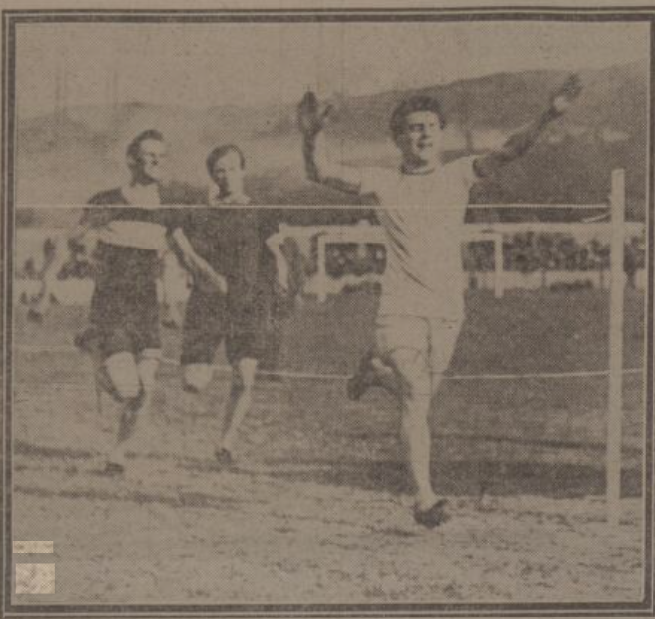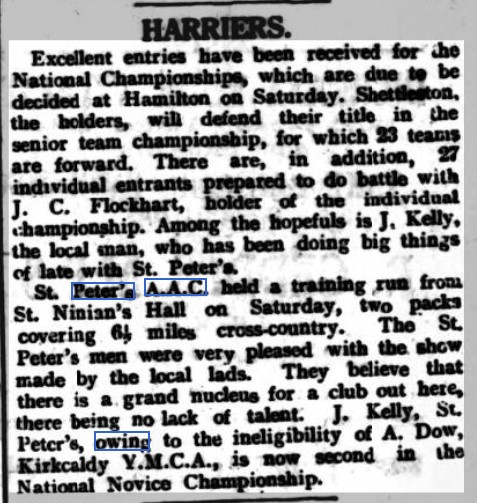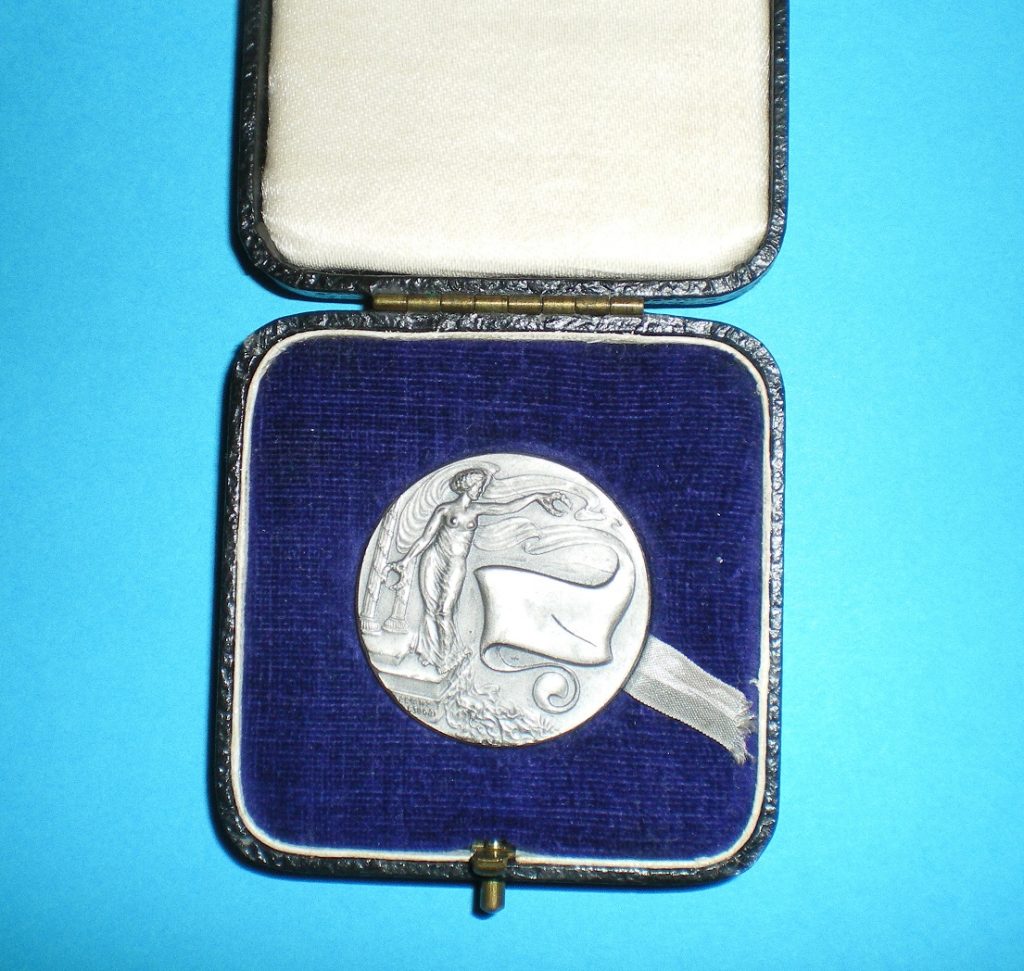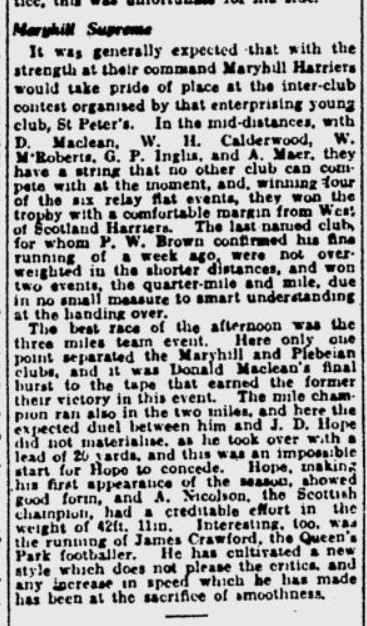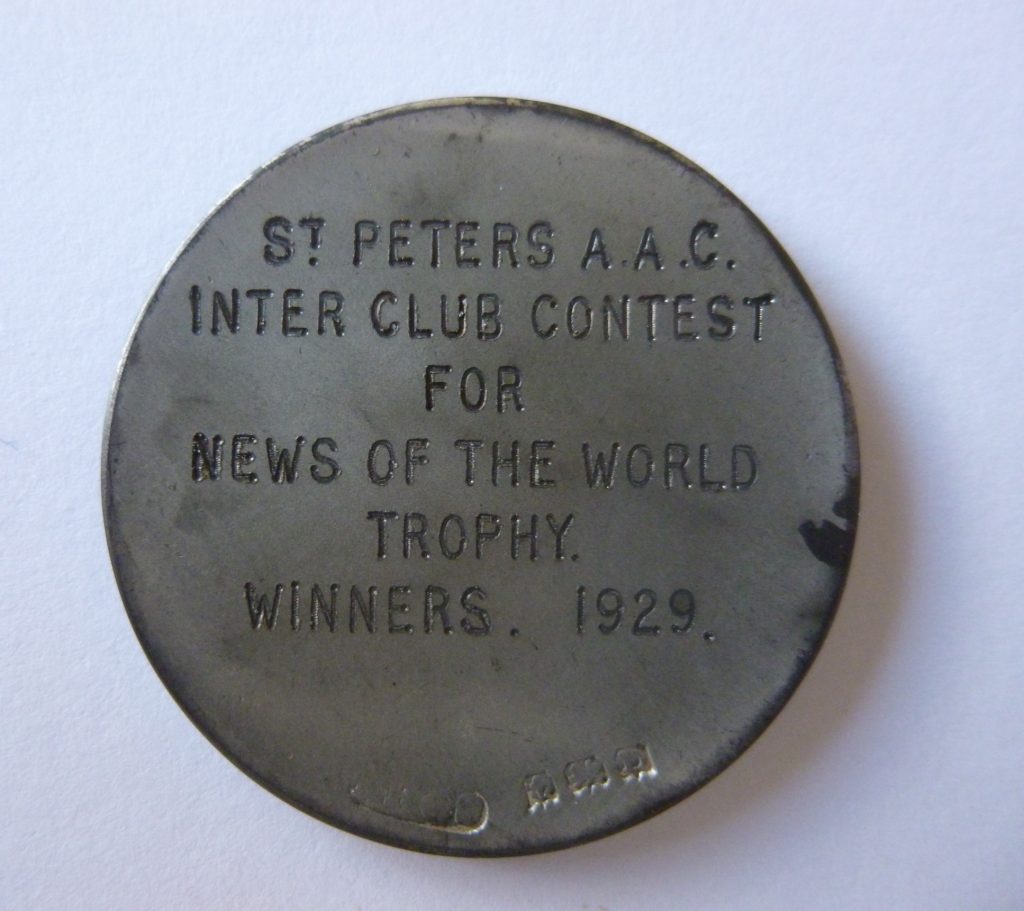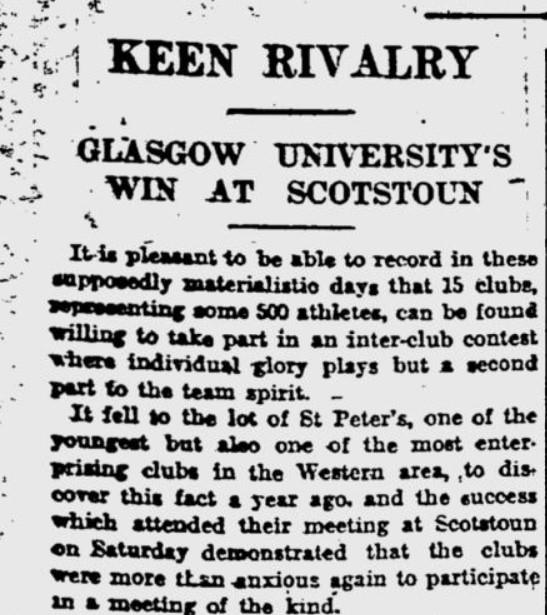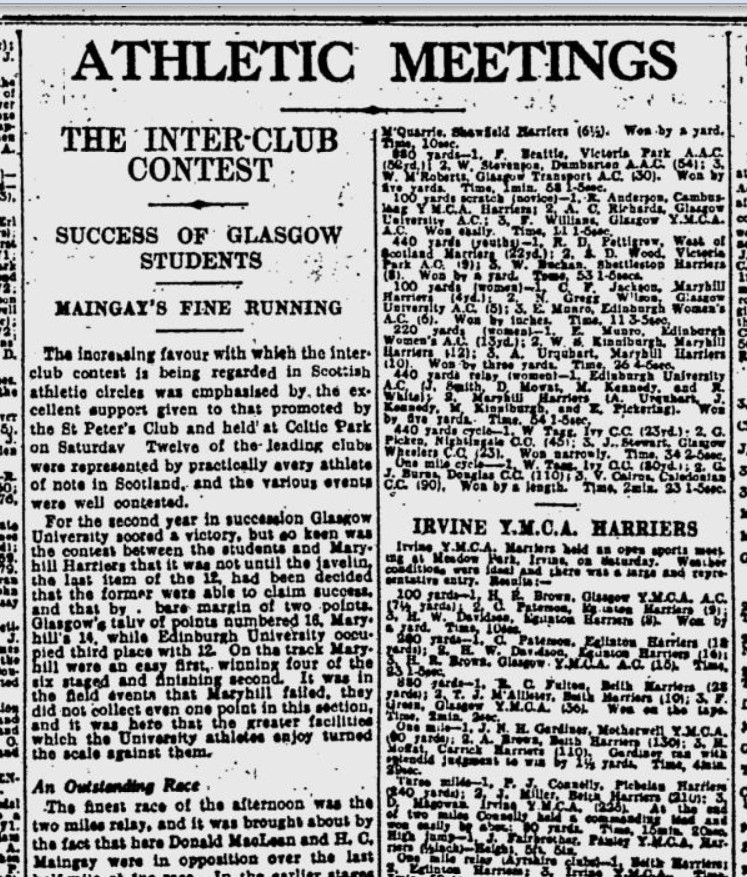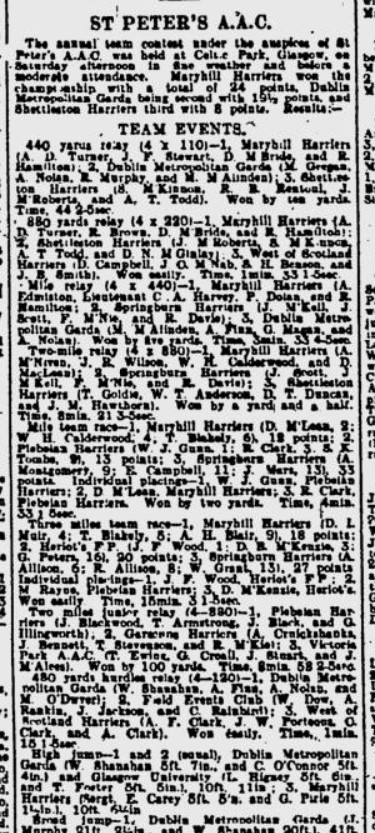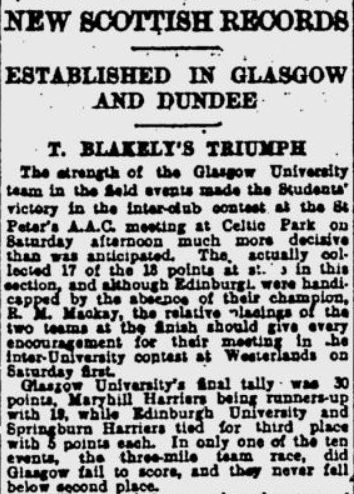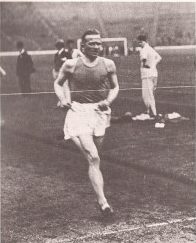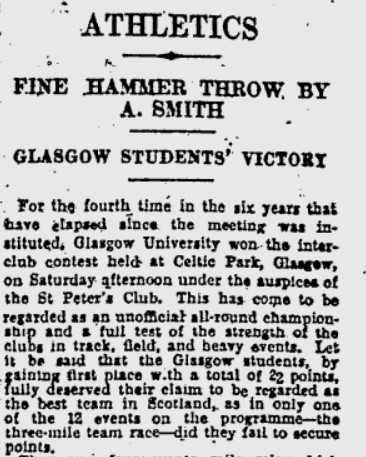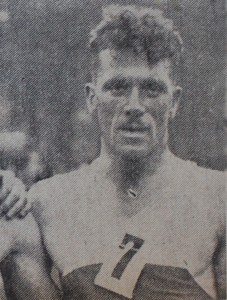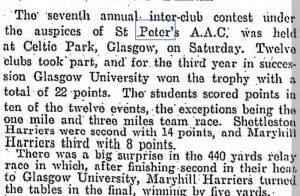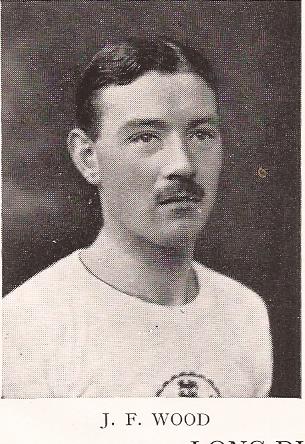JJ McFadden winning the 220 at Morton Sports in June 1915
The St Peters AC was a good club, maybe better in track and field athletics than cross-country, and were well known for their big inter-club meetings held at Celtic Park at the start of June in the 1920’s and early 30’s. They were regarded, and at times spoken of, as the club championships of Scotland. There were relays at every distance from 4 x 110 yards through 4 x 220, 4 x 440, 4 x 880 and 4 x 1 mile as well as having a two mile team race. Clubs had to have real strength in depth to do well at these meetings and all the very best men at the time turned out. This article is mainly about the meetings which took place in the late 20’s and early/mid 30’s. Before we look at them, though, it should be noted that little is known of the club itself now, and despite asking usually reliable authorities and consulting reference books, it was impossible to find the club colours, let alone dates for its institution and demise. That lack of knowledge should not obscure what the club did for the sport during its short (c1911 – c1939) existence. A brief profile of St Peter’s AC should be undertaken. The club was based in the West End of Glasgow but we don’t know just where their headquarters were. In the Charity Sports in August 1911 they were described in the tug o’war heats as ‘St Peter’s AC, Partick’. We know that there is a St Peter’s RC Church in the West End of Glasgow very close to Partick and we also know that they ran their cross-country in the countryside around Drumchapel and Bearsden. Closer than that we cannot get at present.
There is no indication among meeting results of St Peters AC in 1910 and at least one of their members was already competing in the sport. JA Coyle, a good club standard sprinter turned out for several clubs. In 1911 they started to turn out at most meetings in reasonable numbers. For instance on 8th July at a sports meeting, promoted by Celtic FC with funds going to the St Vincent de Paul Charity, the prize winners list included from St Peters AC –
*in the 100 yards open, H McLaughlin won the seventh heat,
* in the 220 yards Parish Championship, M Kavanagh was 2nd, G Forrester was 3rd[
*in the Parish 880 yards race Alexander Oliver was 2nd
*in the open putting the 16lb ball D Bowie was 1st and J Forrester was 2nd,
*in the broad jump M Kavanagh was 1st, and
*in the high jump, M Kavanaghwas second,
*in the overall Parish Championship, St Peter’s AC won. This was the first annual meeting of the kind but it is clear that St Peter’s AC had a fair number of good athletes over a range of events.
Then in August of that year, at the Celtic FC Sports, Kavanagh won the first heat of 17 but did not progress beyond the semi final. At the sports held in aid of the St Vincent de Paul Society – also at Celtic Park -, they had a G Forrester of both Auchmountain Harriers and St Peters AC competing in the 100yds handicap off 8yds and in the 220yds off 22yds. Also mentioned in the Press preview was M Kavanagh off 8.5 yds in the 100, and 19 in the 220 yards. On the actual day, Kavanagh won the 100 yards (novice) in 10 2-5th seconds. There was some success, then, at both individual and team level in its first year of existence.
Many of the same competitors no doubt turned out for the club in 1912, but the club’s biggest showing was at the second Celtic sponsored Catholic Charity Sports on 5th June 1912. M Kavanagh (3rd) and H McLaughlin competed in the 100yds open, C Forrester (1st) and A McLaughlin 2nd; Kavanagh 2nd High Jump; J McAllister won the Parish 220 yards; 880y parish championship A Oliver 2nd, One Mile parish champs A Oliver 2nd; Broad Jump parish champs Kavanagh 1st, Jas Peterson 2nd, Putting the 16lbs ball G Forrester 1st and A McIntosh 2nd and St Peter’s football team won the the 5 a side tournament. In 1913 AJ Oliver competed in the Celtic Sports on the second Saturday in August in the 880yds off a handicap of 50yds and a week later he turned out in the Clydesdale Harriers Sports, this time over Three Miles. Names like Kavanagh, Oliver and Forrester were becoming quite well known.
1914 was the fateful year when the country went to war but before the hostilities started the summer season was almost a complete one for most athletes. Note the following appearances by members of the St Peters club.
*29th May, 1914: Clydesdale Harriers Meeting: 100y JA Farrell, 220 J Kennedy, half-mile J Kennedy, J Oliver, High Jump J Oliver.
* 10 June 1914, East Kilbride Sports: 220: JA Coyle (MH & St Peters), J Forrester, shot putt 6th, hammer 7, Long Jump; Mile J McIntyre, AJ Oliver, 440 AJ Oliver.
19th June, 1914: Clydesdale Harriers Sports: 100y JA Farrell, J Foley, JA Coyle (Maryhill & St Peters) , 220y J Foley, J Coyle, JA Farrell, half-mile AJ Oliver,
26 June, 1914: Babock & Wilcox Sports: John Kerry and JC Weir were back markers in the field of 51 runners, JA Coyle also ran in the 100 yards, , 220y J Kerry and JC Weir again back markers, A McDonald (Maryhill H & StPeters) , 880 yards AJ Oliver, One Mile AJ Oliver,
20 July, 1914: Abercorn Sports: 220 JA Farrell 2nd.
*31st July, 1914 Rangers FC Preview: 100y Open, C Patrick, 220 Open, J Farrell, D Patrick,
* 7 August, 1914: Preview, Celtic Sports: Mile, J Barker, AJ Oliver, High Jump AJ Oliver, 100y Open, JA Farrell, 220 Open C Patrick (Hamilton & St P), JA Farrell, Half-Mile J Morrison, Obstacle Race JA Farrell,
More than a dozen athletes appearing regularly enough to be mentioned in the Press. There are also names appearing of a high standard that do not appear in either 1911 nor 1912 with Kerry and Weir being the notable examples. We also know that JA Coyle had been racing for over a year and for a variety of clubs. St Peters must have been an attractive option for athletes.
During the war, there was a continuation of athletics meetings, albeit fewer and with altered programmes. The Relief Sports held at Celtic Park on 26th June, 1915, featured a ‘Khaki Marathon’ in which 4th Scottish Rifles Number 3 Company won from the regiment’s Number Two company by three minutes. This was typical of the events which were featured during the war with many events confined to the military and there were novelty races such as the stretcher race held at meetings across the country. Among the St Peters members taking part J McFadden was 3rd in the 220 yards and AJ Oliver won the Mile. Many of the athletes had enlisted and were abroad, others were running under the name of their regiment and almost all were training only irregularly if at all. The St Peters football team has been mentioned already but it was not noted that the team was named St Peters AC rather than St Peters FC which is a fairly definite indication of the connection. They are noted as querying the neutrality of a referee in the Scottish Junior Football City & District League. It continued playing during the war. The Relief Fund meeting at Parkhead was held on a very wet and miserable afternoon when many thought that it should be postponed. It went ahead however and £115 was raised. Among the St Peters athletes that afternoon J McFadden was 3rd in the 100 yards. On 30th June 1917, the club was responsible for the sports at Celtic Park in aid of the St Vincent Home and Workshops for the Blind and the Deaf and Dumb Institution at Tollcross in Glasgow. There were only four events with the bulk of the afternoon taken up with a five-a-side football match. It is intriguing that the 200 yards had a popular winner – J McFadden of Shettleston Harriers. Could this be the same J McFadden who had been running so well in 1914, 1915 and 1916 for St Peters? Whether it was or wasn’t, he won his heat and the final of the 100 yards in the Rangers Sports at the start of August, There was actually a connection with Shettleston Harriers in that several St Peters men had been members of the club – John Mackay tells us that – AJ Oliver and P.Murty were members I believe, James Oliver was novice champion of the club 1905-06 and P.Murty was in the novice team which finished 2nd in 1924-25.
Although 1918 saw the end of the war, many soldiers of all nations were still being killed on the continent – eg Ralph Erskine of Clydesdale Harriers, an SAAA 880 silver medallist before the war, was killed in January 1918, men were still being sent abroad to fight and it was noted that the secretary of Maryhill Harriers, Mr E Watt, was currently somewhere in France, another sportsman, footballer Willie Cringan, was about to be posted abroad, and Bert Murray who had played for Aberdeen, Clyde and St Johnstone, was awarded the MC. The war was very much still with the country at large.
The annual charity meeting was held at Celtic Park on 30th June and J McDonald was again 3rd in the 100 yards, but unlike the early days of the meeting there were no St Peters athletes on the short prize lists. The fact that it had been organised by Celtic FC, with Willie Maley involved at the start, but that it was now organised by St Peters, maybe had something to do with it. As for the rest of the season, there were many small meetings, often with the purpose of raising funds for the war effort, and even the big meetings of the year such as the Rangers Sports had a much smaller budget, there were fewer athletes to go round and the meetings were poorly reported in papers that had shrunk to half their size. The war ended and athletics started up again.
Although they were mainly a track and field club, as an all round athletic club, they competed in cross-country as well. They turned out in the national championships but not to the same standard as on the track. eg they were 17th in 1928 (Connor (34), Gaffney (86), Smith (88), (Walsh (124) and McDonald 125), and they were 19th in 1929 (Murty 35th, Gaffney (100), Smith (116), Brady (140), McCrory (156) and Sheerin (162). The best cross-country runner, and track athlete, that they produced seems to have been JJ McDonald. He had been 9th in the West District cross-country championship in 1931/32 leading the team into 11th place with the others being Keenan 16th, Murty 78th, McGuinness 93rd, Walker 94th and McCarthy 125th. That was a very good performance for the club but his own best year was 1932/33. That year he was 3rd in the District Championship and followed home by Cosgrove 73rd, Walker 131st and the other runners were 150, 174 and 177. The team was away down in 19th. The team may have been going backward but McDonald was continuing to improve. At the National that year he won the Youths race but again the Youths team was strung out behind him – H Strange was 55th, J Barry 77th and J Diamond 87th. In 1934/35 there were two Youths from St Peters in the National – J Gibbons was 6th and J Bradley was 9th in a big field of runners but there was no team to support them.
The club had a full team out in the West End Cross-Country Championship at New Year, 1934, – the numbers taking part were big with Garscube, for instance, having nine runners in the race although only five were counters. John Kelly was second, 24 seconds behind the winner, Jack Gifford of Victoria Park. The first real race of thee year was on 6th January when St Peters had a team out in the Edinburgh to Glasgow Relay where they finished 14th of the 15 teams in the race. On 24th January there were runners from St Peters in the Renfrewshire cross-country championships – John Kelly was third, with three men from Kirkintilloch running for St Peters: Kelly, T Cosgrove and T Breslin. The team was also third that afternoon over the seven miles trail from Thornliebank. In March that year, there was a preview of the National with the chances of some club runners mentioned in the clipping below.
Note the absence of any mention of JJ McDonald in any age group at all. There is no indication of a club team or indeed any individual runners in the National or the District Championships from 1934 to the start of the war. A JJ McDonald turned out for Shettleston Harriers two years later but that was the only time he was heard of thereafter. The West End of Glasgow Inter Club Contest took place at Westerton involving Garscube Harriers (who won), Victoria Park (2nd team, Clydesdale Harriers (3rd), Glasgow YMCA and St Peters The race went out via Drumchapel and returned via Temple and each club had at least 5 runners forward. It was the third contest in the series. But if the cross-country team was not doing quite so well, the track and field scene was very different.
They faced the difficulties all cross-country clubs faced – the following extract from the Clydesdale Harriers Minute Book for 19311 tells us a cross-country story:
“In 1931 the club was warned off running over some of the country at Peel Glen (Drumchapel). “Warning Off Ground at the Peel Glen: Mr McQuattie related how two members had been warned off fields at Peel Glen. A letter was received from Garscube that they had had the same experience as also had St Peter’s AAC and suggested that a meeting be convened of St Peter’s, Garscube and Clydesdale. It was agreed that we should attend such a meeting and be represented by Messrs Kirkland and Thursby.” Charlie Middler was roped in as well and the meeting was duly held and he was a member of subsequent meetings with the farmers. The last word at the time was on 5th October 1931: “Deputation to Farmers: C Middler gave a report of the interviews the members of the Deputation had had with the local farmers regarding the crossing of fields.” And that was it. It must have been an amicable solution because the cross country season passed with no further mention of it. This must have been in his mind when at the October 1932 meeting ‘Mr C Middler referred to the fact that some members were crossing the fields during training runs and suggested that they be advised not to do so until the season formally opened in October.”
On the track they continued to thrive as a club and in the 1920’s the club made steady progress. On 12th June 1927, Shettleston Harriers and West of Scotland held a joint meeting at Celtic Park and there were several St Peters men competing. In the high jump, L Higney was third, FH Mooney was 3rd in the 100 yards and P Connor was 3rd in the half mile.
In the Queen’s Park Sports in June 1928, John Whitters was third in the open mile. On 8th August 1925: Celtic Sports High Jump was won by 1st L Higney. .
11th June,1928 – Ernie Harper wins Drymen to Firhill race in near-record time. The annual sports meeting of the Maryhill Harriers was held at Firhill Park in dull weather before 12,000 spectators. The principal event was the 15 mile marathon race, which attracted 29 entries. Ernie Harper, Cpl. Sam Ferris and Dunky Wright ran together until halfway, when Harper drew ahead and at Bearsden he was leading Ferris by 400 yards, with Wright lying about 150 yards behind. Although Wright managed to pass Ferris, he could make little on Harper, who, entering the ground first, broke the tape 400 yards ahead in a time just outside Wright’s course record. Alex Adams, Maryhill, and F. Macdonald, St. Peter’s AAC, shared first prize in the handicap ahead of Donald McNab Robertson, Maryhill.
During the 30’s they were well represented in all the summer meetings with athletes competing well in sports and championships the length and breadth of the country and even winning medals in the SAAA Championships. The most successful athlete with Scottish winner’s medals in the 1930’s was JJ McDonald – we have already seen his cross-country feats but he was equally successful on the track with gold and silver at the SAAA Championships over the half-mile distance. In 1932 he was second in the Youths 880 yards and in 1933 he won the event. He was successful at several of the other sports meetings each summer – eg in 1933 he was third in the Open Youths 880 yards at the club’s big meeting on 5th June, was second in the mile at Saltcoats and second in the half-mile at the St Vincent de Paul Sports. It was not a one-man club however with prizes being won by sprinters JJ Reilly, T McKenna and R McLeod, by quarter-miler J Glancy and other half milers MV Lyons, and novices M Walsh and F Murty; in the year before FJ Gaffney and McDonald were winning prizes at 880 yards (McDonald won the Renfrewshire championship event), P Murty in the Mile and for the women T Kelly was second in the 100 yards in the Renfrewshire championships.
Silver medal presented to the second placed GUAC team in the 2 miles relay in 1929. This one was presented to EM Young of the GUAC 4 x 880 yards team
But if the club is remembered for one big thing, it is the St Peter’s Relay and Team competition of the late 20’s and early 30’s. Held on the first or second Saturday of June (2nd June, 1928; 8th June, 1929; 14 June 1930; 15 June 1931; 6 June 1932; 3 June 1933; 16 June 1934;7th June 1935) they had a double attraction for most athletes
(1) It was a club competition when the whole club could take part – note the format and events below – and there were even some open events for those not making a team but who could be called upon to fill in for any late call offs.
(2) It was two or maybe three weeks before the national championships. A chance for athletes to get some good competition against good opposition as a check on their fitness. And given that it was a relay format, nothing too much could be gleaned from it by the opposition for athletes on any but the first leg of a relay.
The format in the competition for the team trophy was to have every event a team event:
*440 yards relay; 880y relay: One Mile Relay, Two miles relay; Four Miles Relay, 480 yards hurdles relay, one mile team race, 3 miles team race. 4 per team. Not being hurdlers we queried the hurdles relay and why it was 480 yards. Colin Young tells us that it was probably a shuttle relay, there and back using two lanes, rather than a round the track relay!
*Shot Putt, Discus, Hammer, Javelin: 2 throwers distances totalled
*High Jump, Long Jump: two athletes performances totalled
There were minor changes from year to year but that was the general format. The first meeting was in 1928 and the report is shown below in its entirety.
The report on the first of the series held on 2nd June 1928
The reference to Donald Maclean running in both mile and three miles events is interesting as it demonstrates the club team spirit that was in evidence all the way through the programme but there were many who did more than that. Look at the results below.
1928 Results:
440 yards relay: 1. West of Scotland (FW Brown, JG Scott, S Bernstein, FW Clark); 2. Maryhill H (W Anderson, JG Gibson, T McLean, M Kennedy.
880 yards relay: 1. Maryhill H (F Andreoli, DS Duncan, T McLean, R Kennedy); 2. WSH (FW Brown, JG Scott, GA Don, GJ McLennan)
Mile Relay: 1. WSH (AF Clark, FW Brown, DHE Elliott, JD Hope); 2. Maryhill (A Moir, A Edmiston, DS Duncan, W McDonald)
Two Miles Relay: 1. Maryhill (WHM Roberts, WH Calderwood, DS Sharp, DS Maclean); 2. WSH (DE Elliott, EH McIntyre, WN Neilson, JD Hope.
Four Miles Relay: 1. Maryhill (GP Inglis, TW Cowan, WH Calderwood, D McLean); Garscube H (No team available)
Three Miles Team Race: 1. Maryhill (D Maclean 1st, D McL Wright 4th, WH Calderwood 5th); 2. Plebeian H (SH Combe 2nd, WJ Gunn 3rd, FJ Connolly 6th)
High Jump: 1. Maryhill Harriers (KM Smith and D Houston 11′ 3″); 2. Field Events Club (10′ 8″)
Long Jump: 1. 2nd Camerons ((Tait and Rounson 40′ 11″); 2nd Field Events Club (37′ 8 1/2″)
Putting the Weight: 1. Glasgow Police (AC Nicolson and G Mitchell 83′ 10 1/2″); 2. Field Events Club (78′ 3″)
Throwing the Hammer: 1, Field Events Club (J Jackson, W McKenzie No distance given); 2. Glasgow Police.
480 yards hurdle relay: 1. WSH (JW Porteous, AF Clark, T Clark, C Clark); 2. Camerons
News of the World Challenge Trophy: 1. Maryhill Harriers 20 points; 2. West of Scotland 13 points; 3. 2nd Battalion Queens Own Cameron Highlanders.
It is interesting to note that the winners trophy was a ‘News of the World Trophy’ and that the medals as shown by the one below were sterling silver and sponsored by the same newspaper.
The reverse of the medal which, unusually, is maybe more interesting than the front!
First, note the hallmark at the bottom of the medal – very high quality for a medal in such a meeting. There were 12 medals for each race, 7 races in all = 84 medals. If 1st place medals were gold, then that was 28 gold medals + 28 silver medals + 28 bronze medals. Then there were the field events. It was not a cheap wee meeting.
Second, note the News of the World name on the medal. The Sunday newspaper was a great supporter of the sport in those days – we all know about the Inter-City Relays in all parts of the Kingdom with its lavish sponsorship. eg the Edinburgh to Glasgow (known colloquially as the News of the World, had 9 buses running in support, there were several limousines for the officials, results were produced en route and distributed, there were the shiny programmes with a dozen high quality photographs distributed free of cost, the post race dinner in the Ca’doro restaurant and the trophy plus eight medals for each of the three teams plus a set for the most meritorious performance by an unplaced team. They did this for four regional relays and for the champion of champions relay between London and Brighton. That’s one race and there was sponsorship in summer for selected track meetings. No one has ever replaced that kind of sponsorship.
—————————————————————————————————————————————-
This team spirit and preparedness to do more than maybe was good for them as individuals was commented on right at the beginning of the report on the 1929 race. The appearance of University athletes in 1929 was significant since the university athletics scene was very healthy at this point with many of the very best of Scottish athletic talent available to them. They had not competed the year before since the date clashed with the Scottish universities championships.
The start of the report in June 1929
15 clubs took part in 1929 which tells us a lot about the popularity and significance of the meeting. Shettleston Harriers, Plebeian Harriers, Garscube, Bellahouston and West of Scotland were all there. Springburn Harriers, Glasgow University AC, Glasgow YMCA, 2nd Camerons AC, Glasgow Police AC and the Field Events Club were also represented. It was a magnificent turn out and the presence of 500 athletes did not prevent any doubling up by athletes. Look at the results and remember that these do not include all the clubs taking part who were placed third or below in the event.
1929 Results:
440 yards relay: 1.. Glasgow University (W Wright, GJ Smith, I Borland, RA Robb); 2. Shettleston H (W Irvine, J McFadden, A McMillan, J Crawford)
880 yards relay: 1. Glasgow University (W Wright, GJ Smith, I Borland, RA Robb); 2. WSH (PW Duncan. GJ Smith, JC Scott , AF Clark)
One Mile Relay: 1. Maryhill (K Duncan, AD Turner, J Allison, HH Devlin); 2. Bellahouston (WG Lawn, WS Lawn, G Keith, H Doig).
Two Miles Relay: 1. Maryhill (W Herbert, W McRoberts, AH Blair, WH Calderwood); 2. Glasgow University (RW Barlow, EM Young, A McPherson, JA Steven).
Four Miles Relay: 1. Maryhill Harriers (D Maclean, A Kellas, AH Blair, WH Calderwood); 2. Glasgow U (JR Barr, J MacKenzie, WH Dunlop, N Morrison)
Three Miles Team Race: 1. Plebeian H (W Gunn 1, M Rayne 3, J Lamont 10); 2. Springburn H: (J Stevenson 4, R Allison 6, A Stevenson 7)
480 yards hurdles: 1. 2nd Camerons (Tait, Scott, Rowan, Taylor); 2. WSH (AF Clark, JW Porteous, T Clark, C Clark)
High jump: 1. Maryhill (KM Smith + NF Bulloch 11′); 2. Field Events Club (W Malaja + C Rainford 10′ 8″)
Broad Jump: 1. Glasgow U (CM Douglas + AN Lapsley 36′ 6″); 2. Glasgow YMCA (W Sinclair + W Osborne 35′ 5″
Putting the weight: 1. Glasgow Police (A Smith + J Clark 72′ 11″); 2. Field Events Club (AM Murray + G Laidlaw 69′ 6″)
Throwing the Hammer: 1. Field Events Club (W MacKenzie + AM Murray 264′ 6 “); 2. Glasgow Police (A Smith + J Clark 235′ 11 1/4”
Throwing the javelin: 1. Glasgow U (AN Lapolly + C de Vesser 120′ 7″); 2. 2nd Camerons (Ruthven + Robinson 228′ 11″
Aggregate Trophy: 1. Glasgow University 16 pts; 2. Maryhill Harriers 14; 3. 2nd Cameron 9 pts.
Note that there is an extra event involved in this meeting – the javelin had not been included before now.
The meeting of 1930 was different again in that as well as a Three Miles team race, there was a One Mile Team race which took the place of the Four Miles Relay. There were also more clubs picking up prizes and – more to the point – points. Heriot’s AC was one, Dumbarton AAC was another but in particular there was a very good team from Edinburgh University. Both Universities did well and particularly in the field events – GUAC was in the first three in the 440, 880, mile relays, in the one mile team race, in the high jump, broad jump and throwing the javelin (They were also 2nd in hurdles relay but were disqualified) while Edinburgh was in the first three in the 440 yards, mile and two miles and 480 hurdles relays, broad jump, putting the weight, and throwing the javelin. The reporter on the day remarked that Maryhill did not even collect one point in the field events and commented further that the superior facilities enjoyed by the Universities told against them. Maingay, Calderwood, Wright, Wood, Murdoch, Borland and Donald Maclean were all international runners of high pedigree and to have them on the posters and in the Press preview would entice any Scottish athletic aficionado along to Celtic Park.
Borland was SAAA 440 champion in 1929 and 1930, Maingay won the 880 in 1928, ’29 and ’30. Calderwood won the 880 in 1932, the Mile in 1929 and Murodch the 100 in 1934, the 220 in 1931, ’33, ’34 and ’38, Walter Gunn would win the first ever steeplechaae championship in 1934. Among the field event competitors, Nicolcon won the SAAA Shot championship 10 times, Unger won the national Javelin event in 1929, Lapsley the high jump in 1932 – and there are others who were or became champions, but these will serve to indicate the sheer quality of the athletes competing.
And note too that high jumper L Higney of GUAC who cleared 5’8″ on this day, was a product of St Peter’s AC.
1930 Results
449 yards relay: 1. Maryhill H (JC Anderson, D McBride, T McLean, AD Turner); 2. Shettleston H (L Swan, D McKinnon, W Irvine, J Crawford).
880 yards relay: 1. Glasgow University (R Murdoch, JC Britton, W Wright, I Borland); 2. Maryhill H (JC Anderson, D McBride, T McLean, AD Turner).
Mile relay: 1. Springburn Harriers (W McLaughlin, J Scott, J Mackill, R Davies); 2. Glasgow U (RJ Barlow, AD McCarmen (?),JN Miller, I Borland)
Two Miles relay: 1. Maryhill (DT Muir, AH Blair, WH Calderwood, D Maclean); 2. Edinburgh U (AD Lees, MJ Finkelstein, CM Wells, RC Maingay)
480 yards hurdles relay: 1. Edinburgh U (G Decker, CD Campbell, PC Barkin, DH Holmes); 2. Field Events Club (J Jackson, F Rankine, W Dow, C Rainford)
One Mile Team Race: 1. Maryhill (D Maclean, 1st, DT Muir 3rd, AH Blair 4th); 2. Glasgow U (N Morison 2nd, WM Dunlop 11th, D Brander 13th.
Three Miles Team Race: 1. Maryhill (D McL Wright 1st, DT Muir 3rd, D Robertson 4th); 2. Bellahouston H (R Thompson 2nd , R Campbell 6th, D Blackwood 11th) The individual winner was Scottish international runner JF Wood of Heriot’s AC in 14:56.6)
High jump: 1. Glasgow U (LC Higney + GF Richardson 11′; 2 and 3 =. Shettleston (DS McDonald + RS Walker 10′ 8″) and Heriot’s AC (T Robson and G King 10′ 8″)
Broad jump: 1. Edinburgh U (P Barkis + MG Neverweather (??) 40′ 6″); 2. Glasgow U (CN Douglas + AN Lapsley 36 6″)
Putting the weight: 1. Field Events Club (AM Murray + AH Ewan (79′ 71/2″); 2. Glasgow Police (A Nicolson + A Smith 77′ 7 1/2″)
Throwing the Hammer: 1. Glasgow Police (A Smith + A Nicolson 274′); 2. Field Events Club (W McKenzie + AM Murray 270′ 4″
Throwing the Javelin: 1. Edinburgh U (JP Unger + AM Gressa 278′ 11″); 2. Glasgow U (AN Lapsley + I MacPhail 263′ 1″)
1. Glasgow University AC 16 pts; 2. Maryhill Harriers 14 pts; 3. Edinburgh University AC 12 pts.
1931
The 1931 meeting was held on 13th June which was unfortunate – unfortunate because it clashed with the Scottish Universities Championships and so robbed them of the Glasgow and Edinburgh teams that he performed so well in the past few years. However there was an international dimension to the event when the Dublin Metropolitan Garda took part and actually finished second to Maryhill Harriers. The programme was tweaked again and now included a Two Miles Junior Relay (won by Plebeian Harriers) and retained the One Mile team race.
1931 Results
440 yards relay: 1. Maryhill H (AD Turner, JF Stewart, D McBride, R Hamilton); 2. Dublin Metropolitan Garda (M Gregan, A Nolan, E Murphy, M McAlinden).
880 yards relay: 1. Maryhill (AD Turner, R Brown, D McBride, R Hamilton); 2. Shettleston Harriers (J McRoberts, S McKinnon, AT Todd, DN McGinlay)
Mile relay: 1. Maryhill (A Edmiston, Lt. CA Harvey, P Dolan, R Hamilton); 2. Springburn Harriers (J McKell, J Scott, F McNie, R Davis).
Two Mile Relay: 1. Maryhill (A McNiven, JR Wilson, WH Calderwood, D Maclean); 2. Springburn (J Scott, J McKell, F McNie, R Davis).
Mile Team Race: 1. Maryhill (D Maclean 2nd, WH Calderwood 4th, T Blakely 6th); 2. Plebeian Harriers (WJ Gunn 1st, R Clark 3rd, SK Tombe 9th)
Three Miles Team Race: 1. Maryhill Harriers (DL Muir 4th, T Blakely 5th, AH Blair 9th); 2. Heriot’s FP (JF Wood 1st, DR McKenzie 3rd, G Peters 16th)
Two Miles Junior Relay: 1. Plebeian (J Blackwood, T Armstrong, J Black, G Illingworth); 2. Garscube Harriers *A Cruickshanks, J Bennett, T Stevenson, R McKiel.
480 yards Hurdles relay: 1. Dublin Metropolitan Garda (W Shanahan, A Finn, A Nolan, M O’Dwyer); 2. Field Events Club (W Dow, A Rankine, J Jackson, C Rainbird)
High jump: One and two equal. Dublin M G (W Shanahan + C O’Connor 10’11”) and Glasgow U( L Higney + T Foster 5′ 11″)
Broad jump: 1. Dublin MG (J Murphy + W Shanaham 41′ 2 1/2″); 2. Maryhill (Sgt E Carey + J Robertson 39′ 3 1/2″)
Putting the weight: 1. Dublin MG (G Walsh + T Healy 78′ 8″); 2. Field Events Club (AM Murray + F Rankin 75′ 4″)
Throwing the Hammer: 1. Dublin MG (J McSweeney + W Gore 284′ 11 1/4″; 2. Maryhill (A Smith and J Campbell 261′ 5″)
Throwing the Javelin: 1. Shettleston (ER Walker + J McFarlane 266′ 10″; 2. Dublin MG (W Shanahan + J Power 262′ 3″)
The final points totals were 1. Maryhill Harriers 24 points; 2. Dublin Metropolitan Garda 19 1/2 points; 3. Shettleston 9 points.
The strengths of the first two clubs are so obviously different – Maryhill won 6 out of 8 track events, the Dublin team won 5 out of 6 field events (if you include the hurdles relay) and was second in the other. It will also be noted that after the defat the previous year, Maryhill had sharpened up their field events act with points won in two of them.
The meeting on 4th June 1932 had the universities back in the competition – indeed Glasgow University AC was the winning team – but the high spot was the creation of a new Scottish record in the Three Miles team race by Tom Blakely of Maryhill Harriers. His club’s down fall in the overall competition was down to their old failing of not competing as well in the field events as their competitors – Glasgow University on this occasion taking 17 of the 18 available.
1932 Results
440 yards relay: 1. Glasgow University (D Stead, J Clark, AS Kitchen, I Borland) ; 2. Edinburgh University (EL Mark, EA Morison, IG Gaffney, HW Seymour)
880 yards relay 1. Maryhill (PW Byrne, D McBride, JA Bell, P Dolan); 2. Glasgow U (D Stead, J Clark, AS Kitchen, ?)
Mile relay: 1.. Glasgow U (ACC Glen, LB Young, EJ Barlow, IH Borland); 2. Springburn H (F McNie, J McKell, J Scott, LT Montgomerie)
Two Miles relay: 1. Glasgow U (NM Glen, JB Barr, CE Wynne Roberts, N Morison); 2. Maryhill (R Wilson, D Sharp, D Maclean, WH Calderwood)
One Mile Team Race: 1. Maryhill (WH Calderwood 1st, D Maclean 4th, DT Muir 5th); 2. Glasgow U (DM Brander 6th, GM Esslemont 7th, WE Dunlop 10th)
Three Miles Team Race: 1. Maryhill (T Blakely 1st, DN Robertson 3rd, W Nelson 4th); 2. Plebeiean Harriers (SK Tombe 2nd, A Inngram 6th, PJ Connolly 7th) Second individual was JF Wood (Heriot’s FP.
480 yards hurdles relay: 1. Glasgow University (NA Selkirk, JC Taylor, TH Souter, AS Kichin) Walked over.
High jump: Glasgow U (M Craig + GP Richardson 10′ 8″); 2. Springburn (LT Montgomerie + M McWhinnie 10′ 4″
Broad Jump: 1. Maryhill (E Carey + J McCalmont 41′ 5 1/2″; 2. Glasgow U (PRR Ogilvie + AN Lapsley 41′ 4″)
Putting the weight: 1.1. Glasgow U (RG Ratcliffe + JR McGibbon 76′ 7 1/2″; 2. Maryhill (NA Campbell + D Houston 67′ 9″
Throwing the Hammer: 1. Glasgow U (AN Lapsley + JR McGibbon 196′ 5 1/2″); 2. Maryhill (NA Campbell + D Houston 150′ 3 1/2″
Throwing the javelin: 1. Glasgow U (AN Lapsley + NA Selkirk 288′ 9″; 2. West of Scotland (C Clark + A Clark 127′ 3″)
Final Points Total: 1. Glasgow University 30 points; 2. Maryhill Harriers 19; 3. EUAC and Springburn Harriers tied for third on 5 points. As the ‘Herald’ extract says, in only one of the ten events did Glasgow University fail to score – the three miles team race – and they did not ever fall behind second place. Maryhill had greatly improved their field events performances but their track supremacy had diminished, or rather the others had started to catch up and in some cases pass them. The running of I Borland was exceptional and the following extract from the report is relevant here.
“In the two miles the University quartette – NM Glen, JB Barr, C Wynne Roberts and N Morison – ran individually and collectively to their best standard, and possibly a bit more. Donald Maclean made nothing on Roberts in the third section, and WH Calderwood was left with too much to do against Morison on the final leg to give him any prospect of success. Morison took so much out of himself in this race that he was never seen in the mile team race and was not in the lot that counted for second place.
Excellent as these victories were, they were not so glorious as that achieved in the mile relay. That they won here at all was de to the magnificent running of Ian Borland in the last sector. Pitted against LT Montgomerie and called upon to concede the Springburn man 20 yards at the change over, Borland’s task seemed an impossible one . Coming down the back straight, Montgomerie went all out, and Borland was unable to get within striking distance. A wonderful burst of speed over the last furlong enabled him to catch his man in the straight and win.
It was the best race of Borland’s career and confirmed the impression gathered at the University meetings that he was much stronger and faster than last season. He was unofficially timed at 49.6 from take-over to tape which is excellent running indeed, even allowing for the flying start.”
Tom Blakely, Maryhill Harriers
1933 was another very good year for Glasgow University and Edinburgh Universities – Glasgow won the trophy and Edinburgh was again third equal, this time with Maryhill instead of Springburn Harriers. Note the summary below from the ‘Glasgow Herald’
Many of the well-known names from past meetings such as WH Calderwood, D Maclean, I Borland, JF Wood, W Gunn, SK Tombe, AN Lapsley, A Nicolson and so on were again doing battle for their clubs. The number of clubs appearing on the lists of the first two or three had grown hugely since the first meeting. Clubs from east and west of Scotland had taken part, an Irish team had been competitors, there Glasgow Police, team and military outfits (plural) over the years, School FP’s(Heriot’s FP) and the specialist Field Events club. Club athletes had rubbed shoulders with University athletes and it had seen many Scottish champions, record holders and internationalists lining up in the various events. It was and continued to be a very successful venture for what was a relatively small club.
1933 results
440 yards relay: 1. Maryhill Harriers (AD Turner, D McBride, JG Ball. PW Brown); 2. Edinburgh University (LG Gaffney, AC Black, RG Wylde, RA Morrison).
880 yards relay: 1. Maryhill H (FW Brown, JG Ball, D McBride, AD Turner); 2. Glasgow University (RN Robertson, AW McCosh, A McVicar, J Clark)
Mile relay: 1. Glasgow University (HM Murray, LB Young, W Wright, NM Glas(?)); 2. Glasgow Police (J Scott, J Shaw, JR Wilson, R Davis)
Two miles relay: 1. Glasgow Police (JR Wilson, J Lyons, R Davis, J Scott); 2. Glasgow University (CR Wynne Roberts, LR Young, G Whitelaw, N Morison.
480 yards hurdles relay: 1. Edinburgh U (RR Wylde, G Peat, CD Campbell, PE Martin) 2. West of Scotland (A Clark, GW Porteous, C Clark, FW Clark)
One Mile Team Race: 1. Shettleston Harriers (W Sutherland 2nd, M McCubbin 3rd, RG Young 12th); 2. Garscube Harriers (L Lindsay 5th, AD McDonald 7th, GJ Girvin 8th). 1st individual: D Maclean Maryhill.
Three Miles Team Race: 1. Plebeian Harriers (SK Tombe 1st, WJ Gunn 2nd, AT Armstrong 5th); 2. Maryhill (W Nelson 3rd, D Robertson 4th, DT Muir 9th)
High jump: 1. Glasgow U (AN Lapsley + RJ Gourlay 10′ 10 1/2″; 2. Edinburgh U (JD Watt + RE Martin 10′ 9″)
Broad Jump 1. Glasgow University (RN Robertson + PRR Ogilvie 43′ 5 1/2″); 2. Edinburgh U (RE Martin + J Munro 42′ 7 1/4″)
Putting the weight: 1. Glasgow Police (AC Nicolson + A Smith 78′ 2″); 2. Glasgow University (RC Ratcliffe + JRM Gibson 42′ 7 1/4″)
Throwing the hammer: 1. Glasgow Police (A Smith + A Nicolson 292′ 5 1/2″); 2. Field Events Club (W McKenzie + J Jackson 242′ 5″)
Throwing the javelin: 1. Glasgow University (AN Lapsley + D Morrison 303′ 9 1/2″); 2. Shettleston Harriers (ER Walker + J McFarlane 267′ 11″)
There were also several open events at these meetings – the number of team competitions, the effort required in any one of them and the number of athletes doing two, three and sometimes four events meant that there would inevitably be some injuries, some strains and sprains and so reserves were also an essential prerequisite of any club team. So there were several open events to keep these athletes warmed up and add to the recovery time between relays and team events generally. In 1933 there were four open events and three races for women. In the men’s events, JJ Reilly of St Peter’s was second in the 100 yards and in the 220 yards while JJ McDonald was third in the Youths 880 yards. There were also runners from Motherwell YMCA and Monkland Harriers in these events and one of the Motherwell men was destined to become as very well known figure on the athletics scene as a runner and then as an official of note – RR Craigen, better known as Bobby.
Sam Tombe, Plebeian Harriers
That’s a story right there. There is nothing as exciting in track and field as a close run relay. The above headline came from a report on a meeting held annually for clubs in the West End of Glasgow – Victoria Park, Clydesdale, Garscube, Glasgow YMCA and St Peter’s all took part in the spectacle which took place at Scotstoun Showgrounds just a matter of weeks before the big club championship meeting. The event had been taking place since 1931 with Garscube being top dogs for every meeting although the new Victoria Park AAC (founded 1930) was looking like a serious challenger. The programme was entirely made up of and completely composed of relay and team races. The report in the Milngavie and Bearsden Herald of St Peters meeting on 1st June, 1934, read as follows:
“The final track event, the medley race, finished up amidst a state of intense excitement, during which many of the spectators invaded the track, yelling themselves hoarse as the two runners, out in front of the other competitors, rocked and swayed down the home straight to the tape. The excitement began when JJ McDonald, St Peter’s, handed over a yard or two ahead of T Armstrong, Garscube. In the first stretch over the furlong, Garscube gained supremacy, which they held over the next leg. Thus, W Brackenridge set off 5 yards ahead of J McKenna, St Peters, over the last quarter. Slowly but surely the St Peter’s man drew up on his man, and, coming into the finishing straight was hanging on his shoulder. Both put in a mighty effort, and still Brackenridge remained those few inches in front. Nearer the tape they came, spectators on ether side and immediately behind shouting encouragement. And the finish. With his last ounce of strength, McKenna threw himself at the tape, beating his plucky rival by inches. Both men collapsed in a heap serving up a magnificent ending to a magnificent contest.”
The meeting was won comfortably by Victoria Park from Garscube with St Peter’s third. The meeting contained a 4 x 110, a 4 x 220 and the medley relay.
That the relays attracted great support was not in doubt, and the fact that St Peter’s was involved encouraged was a real incentive for the upcoming meeting.
The 1934 championships took place on 16th June – the third Saturday of the month instead of the first. The report from the Scotsman began as follows:
There was more than one change to the programme in 1934. There were two clubs on the results sheet who had never appeared there before: Shawfield Harriers who had a brief but fairly successful period in Scottish athletics was one and the other was Victoria Park AAC. Founded in 1930 in the West End of Glasgow, it went from strength to strength becoming one of the best clubs in the land and for a period in the 1950’s and 60’s had a very good claim to being the best. There were also several good athletes on display but Bobby Graham of Maryhill ,who would have a sparkling career in domestic athletics and run in the Berlin Olympics, was the pick of them all . Unfortunately only the members of the winning teams were given in both the Scotsman and Glasgow Herald, the exception being the High Jump.
Results, 1934
440 yards relay: 1. Maryhill Harriers (AD Turner, D McBride, J Brown, AC Williamson); 2. Glasgow University; 3. Bellahouston Harriers
880 yards relay: 1, Glasgow U (IH Bishop, N Stone, RN Robertson, R Murdoch); 2. Maryhill H; 3. Glasgow Police
One Mile Relay: 1. Springburn Harriers (C Campbell, J Carson, J McKell, A Campbell); 2. Glasgow U; West of Scotland.
Two Miles Relay: 1. Maryhill; (R Graham, D Maclean, T Scoles, WH Calderwood); 2. Glasgow U; 3. Victoria Park AAC
One Mile Team Race: 1. Plebeian Harriers (WJ Gunn 1st, AS McGregor 4th, A Robertson 8th); 2. Shawfield Harriers; 3. Shettleston Harriers.
Three Miles Team Race: 1. Garscube Harriers (J Bennett 3rd, L Lindsay 5th, D Brooke 7th); 2. Shettleston; 3. Springburn.
480 yards Hurdles relay: 1. Glasgow U (AM Chassells, JA Kitchin, TH Souter, AS Kitchin); 2. Shettleston; 3. West of Scotland.
High jump: 1. West of Scotland (C Ramsay + TD McKie 11’5″; 2. Glasgow U (AF McDonad + AS Kitchin 11′ 2 1/2″); 3. Shettleston (ER Walker + W Buchanan 10′ 8 1/2″)
Broad Jump: 1. Glasgow U (TH Souter + RNM Robertson 39′ 9 1/2″); 2. Glasgow Police (S Hewitson + T Seton 38′ 2 1/2″; 3. Shettleston (W Buchanan + ER Walker 37′)
Putting the weight: 1. Shettleston (JK Braid + ER Walker 79′ 4 1/2″); 2. Glasgow U (75′ 10 3/4″); 3. Glasgow Police ( 75′ 9″)
Throwing the hammer|: 1. Glasgow Police (D Maclean + D Campbell 276′ 10 1/2″); Glasgow U (239′ 2 1/2″; 3. Shettleston (235′ 7″)
Throwing the Javelin: 1. Shettleston (ER Walker + J McFarlane 283′ 2″; 2. West of Scotland (269′ 11 1/2″); 3. Glasgow U241′ 7 1/2″)
In the open events on the day, St Peters had three prize winners – JJ Reilly who was 2nd in the 100, J McAulay won the 880 yards for youths and G Dynes was second in the Mile.
The 1935 meeting reverted to the second Saturday of the month but the format remained the same. It was reported to be a dismal day and that was maybe appropriate. The fixture list was becoming increasingly crowded and there were more and more events being held every week. On the third Saturday it had been up against the might of the Glasgow Police Sports. Formerly a professional meeting, it had become an amateur affair and was held at Ibrox Park with a much bigger budget than the smaller club. It was accordingly a bigger meeting with more events, more attractions and more big names. Pipe Bands, Tug O’War, Cycle Races, athletics matches were all on display; in addition it took away the Glasgow Police AC team from the St Peters meeting as well as individual policemen who ran for their local clubs. There were possibly also bigger individual prizes rather than the medals, no matter how precious the metal of the medal. The team meeting however took place on 9th June in 1935.
Results, 1935.
440 yards relay: 1. Garscube H (G Walker, J McIsaac, JT McIsaac, T Paterson); 2. West of Scotland; 3. Maryhill.
880 yards relay: 1, Bellahouston (H Thomson, J Gallacher, WH Lawn, C France); 2. West of Scotland; 3. Maryhill.
Mile Relay: 1. Maryhill (G Terry, G Cairns, H ?, H Morrison); 2. Victoria Park; 3. West of Scotland
Two Miles Relay: 1.Maryhill (D McLean, H Morrison, R Osborne, WH Calderwood); 2. Victoria Park; 3. Plebeian H.
One Mile Team Race: 1. Maryhill (D Mclean 1st, L Osborne 7th, WH Calderwood 8th); 2. Garscube H; 3. Plebeian .
Three Miles Team Race: 1. Bellahouston (J Campbell 1st, T Lamb 2nd, G Hunter 5th); 2. Maryhill; 3. Plebeian
480 yards hurdles relay: 1. Bellahouston (CJ Gordon, M Arnott, J Wyper, OR Gordon); West of Scotland were first but disqualified.
High jump: 1. West of Scotland; 2. St Peters AAC; 3. Victoria Park
Broad Jump: 1. West of Scotland; 2. Bellahouston H; 3. Victoria Park
Throwing the javelin: 1. West of Scotland; 2. St Peters AAC; 3. Victoria Park
Throwing the discus: 1. St Peters AAC; 2. Victoria Park; 3. West of Scotland
Putting the shot: 1. St Peters AAC; 2. Maryhill; 3. West of Scotland
The coverage was not good – the entire ‘report’ in the Glasgow Herald only ran to 11 lines of small print. In 1935 coverage of athletics in order of reporting in the Herald was – first and biggest by far was the Inter University Championships, then came The Motherwell & Wishaw Police meeting which was a very big meeting with lots of events with 13 open athletics events for men and women, as well as cycling and 5-a-side football, then the St Peters meeting, followed by the Catrine AC meeting, then there was an inter-club meeting at Penicuik and finally the Lanarkshire Police meeting with 12 open events (including a pole vault, cycle races and events confined to the police. The last of these was a professional meeting but no matter, it attracted an athletics loving public. Changed days from 1928 when it dominated the headlines.
Other than the performances by Victoria Park athletes, and the improved performances by Bellahouston Harriers the teams competing and winning were pretty well the same as in the first meeting. If the top athletes were heading for the Police Sports one week and the University championships the other, with the SAAA championships towards the end of the month, there was no point in clubs entering teams minus all or most of their top athletes. Whether Press coverage influenced the spectators, or whether the Press followed the public, neither was favouring the club championship of Scotland for the past two years.
eg In 1936 the first Saturday of the month had the Queen’s Park FC meeting at Hampden, School Sports (Glasgow High, Allan Glen’s, Hutcheson’s Grammar, Hillhead High, Greenock Academy, Watsonians and more) and the Foundry Boys Championships ; the second Saturday had the Universities championships, the Inter-Scholastics Championships, Babcock & Wilcox Sports and the Lanarkshire Police Sports; the third Saturday had the Glasgow Police Sports, The Glasgow Academy Sports, 15 schools in competition at Cumnock and Jordanhill College Sports; the fourth Saturday of course was the SAAA Championships with a host of minor sports meetings on the same day.
St Peter’s did not appear n the last week end in May or the first week end in July. The meeting was no more.
Ironically, it was a time when the club athletes were appearing more and more in the athletics press and when relay racing was as popular as ever (see the report above!
Away from the June meetings organised by the club, the individual athletes were performing well in the 1930;s. We cannot give all their results here, they are too numerous, but have a look at these to see the spread of events and the number of athletes involved. A brief curvey of the period reveals the following appearances by St Peters members.
July 1932. PJ Gaffney for Tailtean Games in Dublin
June 1933: Tom Cosgrove, JJ McDonald ran at Renfrew – a St Peters one-two in the mile. June 1933
June 19, 1933 – Glasgpw Police Sports – J Reilly 2nd in 220; 880 yards relay (Women) 3rd St Peters;
June 1st, 1934: West End of Glasgow Contest – VP, St Peters, Glasgow YMCA, CH, Garscube – 6 track, 4 field – Garscube, VP, YM. Report
June 16, 1934 – J McAulay Y 880y 1st; Open mile: G Dynes 2nd
June 1935, RC Archer 2nd Javelin; 3 x 880 relay – 2nd; TC Boyle, 2nd Novices 100 yards;
8th June 1935: Inter Club at Celtic Park Throwing the discus (2 men added) 1st; Putting the weight 1st; Throwing the Hammer 2nd; throwing the javelin 2nd. A McDonald, J McDonald, JR McDonald and J Mackrell were also competing under the club’s banner..
1935 Police Sports: Shot – J McDonald 4th;
20th June 1936: Police Sports Putting 16lb ball 1st J McDonald
5th September 1936: At Campsie Sports, Lennoxtown: One Mile Flat Race: 1. John Brinkins.
This last was very interesting. Brinkins also won the One Mile |Novice Cycle Race and the Two Miles Novice Cycle race under the banner of the Glasgow Wheelers Club after winning the confined (to locals) mile race as St Peters AC. The report in the Milngavie & Bearsden Herald read “”Another attraction was the appearance of John Brinkins, the noted Milton-of-Campsie cyclist, whose success in the Glasgow Wheelers Cycling Club 50 mile Lomond Road Race was recently chronicled. Brinkins who was a road racer was, we understand, making his first appearance on the track”
And then St Peters AC just seemed to disappear. Historian Hamish Telfer says: “The last mentions I have are one at the SAAAs champs on 24th June, 1939 with an AC Nicolson Putting the ‘Ball’ 40′ 4.25” to place 3rd. It should be noted that this AC Nicolson competed for Glasgow Police at this SAAAs champs held at Hampden. He appeared earlier in the month at the Burgh Police Annual Sports (Motherwell) on 7th June for St Peters coming 2nd in the Putting the ‘Ball’ open handicap with 43′ 10”.”
And that’s where we have to leave the story of St Peters AAC and their marvellous meetings. Times changed and the top athletes were attracted more by big meetings such as the Queen’s Park FC and the Glasgow Police meetings, add to that the large numbers of local sports meeting such as the Singers Sports in Clydebank, Beith Sports and the Babcock Sports and June was a very full month with opposing athletics events pretty well all over the country. We are still looking for information on St Peters AAC.
